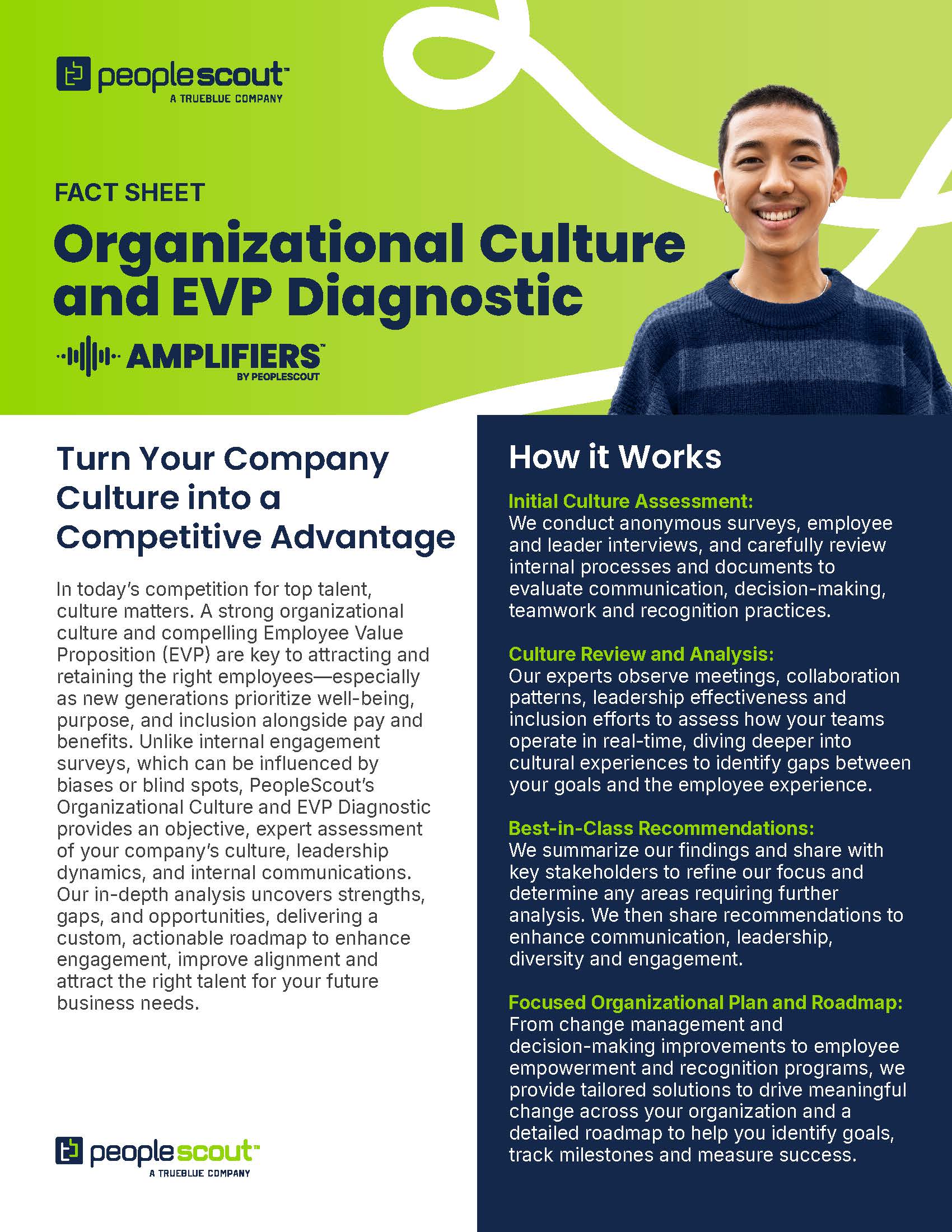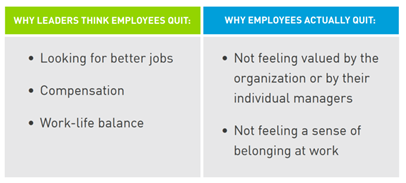Solution: Employer Brand
Beyond Intuition: Data-Driven Employer Branding for the Modern Talent Landscape
With the research today’s candidates do before applying, a strong employer brand is no longer a nice-to-have—it’s essential. Your employer brand directly impacts your ability to attract and retain top talent, yet for many talent acquisition leaders, demonstrating the value of employer branding remains challenging.
How do you quantify something that often feels intangible? How do you translate employer brand sentiment into metrics that resonate with stakeholders outside HR?
The Employer Branding Paradox
Despite 80% of HR leaders believing employer branding significantly impacts their recruiting efforts, only 8% report having a dedicated budget for these initiatives. This disconnect highlights a fundamental challenge: without concrete metrics and benchmarks, employer branding can be relegated to a “nice-to-have” rather than recognized as the strategic driver of recruitment success that it truly is.
The reality is that today’s candidates approach job searches with consumer-like behavior. They research, compare and evaluate potential employers with unprecedented thoroughness.
Your employer brand is front and center whether you’re actively managing it or not.
From Gut Feel to Data-Driven Strategy
For too long, employer branding has relied on subjective assessments and anecdotal evidence. Leaders might know intuitively that their brand needs improvement, but without comparative data, it’s difficult to:
- Identify specific areas requiring attention
- Prioritize investments for maximum impact
- Demonstrate ROI to key stakeholders
- Track progress over time
- Understand how you stack up against competitors
This is precisely why we’ve developed the Outthink Index—a proprietary benchmarking tool designed to transform employer branding strategy from an art to a science.
Introducing the Outthink Index by PeopleScout
The Outthink Index by PeopleScout provides comprehensive analysis across nine critical components of employer branding:
- Search: Are your job openings easy to find in digital spaces?
- Social Reach: What’s the breadth of your social media footprint? Are you achieving significant reach through interactions and engagement across audiences?
- Social Authority: How much of the conversation does your brand own compared to competitors? How influential is your voice in the talent marketplace?
- Social Impact: How effectively does your content engage your audience? Are you interacting with your talent audience on social media or just posting?
- Values & Proposition: How clearly articulated and differentiated is your EVP? Are your values clear, authentic and evidenced?
- Employee Experience: Can candidates get a clear understanding of what life is like within your organization?
- Content: How compelling and relevant is your employer brand content? How authentically does it showcase your organization and your employees?
- User Experience: How seamless and intuitive is your career site and application process?
- Candidate Experience: How transparent, consistent and innovative is your recruitment process?
Built by our in-house talent advisory experts and leveraging data from hundreds of employer brands, the Outthink Index delivers actionable insights with just a few clicks.
Translating Insights to Action
One of the most valuable aspects of the Outthink Index is its comparative nature. While self-assessment can identify obvious gaps, true optimization comes from understanding how you measure against both industry benchmarks and specific competitors.
The real power of data-driven employer branding isn’t just in the metrics—it’s in what you do with them. The Outthink Index is designed to facilitate more productive conversations with stakeholders by providing concrete evidence of:
- Current employer brand strengths and weaknesses
- Competitive positioning within your industry
- Specific improvement opportunities with the highest potential ROI
- Progress tracking over time
The Outthink Index helps companies to transcend gut instincts and harness concrete insights to maximize their employer brand. It provides organizations with precise visibility into how their brand measures up against competitors, highlights specific enhancement opportunities, and ultimately strengthens their capacity to attract and retain exceptional talent.
Armed with these insights, talent leaders can make more strategic decisions about where to invest resources, how to refine messaging and which touchpoints in the candidate journey need the most attention.
The Future of Employer Branding is Data-Driven
Employer branding isn’t a one-time project but an ongoing strategic initiative. The Outthink Index provides both a snapshot of current performance and a framework for optimizing and measuring progress over time. By establishing clear benchmarks today, organizations can track the impact of their employer branding initiatives, demonstrate concrete ROI and continuously refine their approach.
As the competition for talent continues to intensify, organizations that take a data-driven approach to employer branding will gain a significant advantage. The Outthink Index by PeopleScout equips talent leaders with the tools they need to transform employer branding from an intangible concept to a measurable business driver.
Want to see how your employer brand stacks up? Explore the Outthink Index or contact us to receive your custom report.
Wates: Reconstructing Industry Perceptions Through Vibrant Employer Branding

Situation
The construction industry’s image has remained virtually unchanged for years—dominated by hard-hats, high-vis, and steel beams rather than stories highlighting inclusion, innovation, collaboration or opportunity.
When Wates, a UK development, building and property maintenance company, needed to recruit 81 trainees across 21 roles and 28 locations, our priority was to stand out meaningfully in a crowded market. Despite its impressive 125-year legacy as an industry leader, Wates suffered from limited brand awareness.
Our objectives were clear:
- Raise overall awareness of the Wates organization
- Encourage a shift in industry perception
- Attract a more diverse range of candidates
Solution
With these hard-to-fill roles distributed nationwide, we needed a targeted approach. Based on research, we developed four distinct audience personas that represented our target demographics, which then informed our channel strategy and creative approach.
Authentic Messaging
We crafted a new compelling, narrative that brought together everything Wates stands for:
Creating tomorrow together.
Headlines embodied Wates’ core values, speaking directly to the impact individuals would have on the company’s legacy while highlighting key benefits of joining the organization.
Distinctive Visual Identity
We developed bold, vibrant visuals that stood apart from industry norms. Our creative approach demonstrated how professional and personal lives intertwine, visually representing work-life balance and inclusivity. A dedicated photoshoot allowed us to not only capture images but also collect employee stories that inspired a bespoke set of illustrations.

Inclusive Assessment Process
We redesigned the video interview process to ensure accessibility for all candidates. While maintaining a standardized process to ensure fairness, each of the 21 roles required careful manual shortlisting based on performance metrics. With 343 candidates advancing to assessment, we conducted virtual assessment centers over three weeks, with each role getting a dedicated day.
Results
The campaign generated exceptional engagement:
- 518,000 impressions (40% from TikTok)
- 7,918 applications
- 2,022 candidates invited to video interview
- 343 candidates progressed to assessment centers
- 30% female representation at application stage, increasing to 34% at offer stage
- 117 offers extended
“We’re delighted with the quality of candidate applications and how much the collaborative work ethic stood out.”
– Annette, Wates
At a Glance
- COMPANY
Wates - INDUSTRY
Building & Construction - PEOPLESCOUT SOLUTIONS
Talent Advisory - ABOUT WATES
The Wates Group was established in 1897 and is one of the leading privately-owned, construction, development and property services companies in the UK. They employ almost 6,000 people, working with a range of clients and partners from across the public and private sectors.
Amplifiers™: Organizational Culture & EVP Diagnostic
PeopleScout Amplifiers™: Organizational Culture & EVP Diagnostic
As part of our suite of modular recruiting solutions, Amplifiers™, PeopleScoutʼs
Organizational Culture and EVP Diagnostic provides an objective, expert assessment
of your companyʼs culture, leadership dynamics and internal communications.
Our in-depth analysis uncovers strengths, gaps and opportunities, delivering a
custom, actionable roadmap to enhance engagement, improve alignment and
attract the right talent for your future business needs.
Download this fact sheet to learn more.

Learn more about PeopleScout’s Amplifiers™ and get answers to frequently asked questions (FAQs).
Dig into More Talent Insights

Specialist Hiring: Maximizing Success with Targeted Talent Sourcing
Situation A local authority in the southwest of England had a robust talent acquisition team but required additional support for front-end headhunting and sourcing assignments. A new and niche position for a harbor master demanded a comprehensive strategy to locate the right specialist. A habor master ensures the safety of all users of a harbor,…

Why Small and Medium Enterprises Should Consider Recruitment Process Outsourcing
Small and medium-sized enterprises (SMEs) face unique challenges in attracting and retaining top talent. Limited resources, lack of dedicated recruitment teams, and the need for agility in hiring can often put smaller businesses at a disadvantage. That’s where Recruitment Process Outsourcing (RPO) comes in— a versatile strategy that businesses of all sizes can leverage to…

Debunking RPO Myths: How Savvy Talent Leaders Separate Fact from Fiction
Get ready to separate fact from fiction as we dismantle RPO myths
Nurse Retention: Key Strategies for Tackling Turnover
In today’s dynamic healthcare landscape, the challenge of nurse retention has emerged as a pivotal issue with far-reaching consequences. The ripple effects of nurse turnover extend beyond the immediate strain on existing staff, impacting patient outcomes, increasing wait times and potentially leading to the reduction or elimination of vital services. Plus, the financial burden of recruiting, hiring and training new nurses places significant pressure on healthcare organizations already grappling with tight budgets.
Enhancing nurse retention has become an imperative for healthcare organizations seeking to maintain quality care and operational efficiency. In this article, we’ll explore nurse turnover trends and delve into practical strategies for nurse retention.
What’s Driving Nurse Retention Challenges?
To develop effective nurse retention strategies, it’s crucial to identify the primary drivers of nurse turnover. Recent years have seen a significant increase in nurses leaving the profession, with several key factors contributing to this trend:
Pandemic-Induced Burnout and Workforce Shrinkage
The strain of the COVID-19 pandemic, coupled with an already shrinking workforce, has led to unprecedented levels of burnout among nurses. This has resulted in a marked increase in turnover rates. The American Association of Colleges of Nursing reports that RN turnover rates in the U.S. rose from 17% in 2017 to 26% by 2021. Plus, over 25% of RNs indicate plans to retire or leave nursing within the next five years.
Rising Labor Costs and Budgetary Pressures
Healthcare organizations are grappling with increasing costs for salaries, benefits and contract staffing, exacerbated by nationwide labor shortages and inflation. This financial strain is further compounded by the heavy reliance on contract and travel nurses to maintain patient care standards. According to the American Hospital Association, the proportion of nurse labor expenses allocated to contract travel nurses skyrocketed from 4.7% in 2019 to 38.6% in January 2022. While travel nurses accounted for nearly a quarter (23%) of total nurse working hours, they represented nearly 40% of all nursing labor costs for hospitals.
Impact on Staff Morale and Retention
The increased use of traveling nurses, while necessary to address staffing shortages, often has unintended consequences on staff morale. Staff nurses can become aware of the significant pay disparities between themselves and travel nurses, which can create a cycle where more staff nurses leave for higher-paying contract or travel positions.
Addressing these interconnected issues is essential for healthcare organizations aiming to create a more supportive and fulfilling work environment. By tackling the root causes of nurse turnover, organizations can work towards improving nurse retention rates and ensuring sustainable, high-quality patient care.
How to Improve Nurse Retention: 5 Nurse Retention Strategies to Combat Turnover
Here are some nurse retention strategies aimed at creating a supportive, engaging work environment that encourages long-term commitment and professional growth.
1. Address Burnout Proactively
Burnout is a growing challenge in today’s high-stress healthcare environment. Addressing it through tactics like regular check-ins and support systems for staff are crucial to identify issues before they lead to turnover. Offering on-going stress management and resilience training equips nurses with tools to cope with the demands of their roles.
Moreover, creating a culture of appreciation can significantly impact job satisfaction and retention. But in our post-COVID reality, celebrating once a year for Nurses’ Week isn’t enough. Peer recognition programs and sharing patient success stories and positive feedback reinforces the meaningful impact of their work and reminds them why they got into the nursing profession.
2. Support Work-Life Balance
Another important part of addressing burnout and improving nurse retention is actively encouraging nursing staff to prioritize work-life balance. Embracing flexible working patterns can go a long way to helping nurses balance work and personal commitments and bounce back from stress. Consider compressed working hours, job sharing and set working days. Implement policies to prevent mandatory overtime where possible. Plus, allowing nurses to negotiate shifts that suit their needs and to rearrange their schedules among themselves can boost staff morale and job satisfaction.
Consider adding benefits like on-site or subsidized childcare options or elder care support services. This can be a significant draw for nurses with young families and acknowledges the caregiving responsibilities many nurses face outside of work. Plus, providing opportunities to improve their own health and well-being by offering wellness programs and gym memberships as part of your benefits package ensures nurses have resources to help them cope with stress and improve self-care.
3. Invest in Continuous Education and Skill Development
Investing in continuous education and skill development is a win-win for both nurses and healthcare organizations. Providing on-site training for new technologies and procedures keeps staff current and engaged. Offering opportunities for nurses to attend conferences and workshops broadens their professional networks and knowledge base. For nurses, supporting them through reimbursing for obtaining additional certifications demonstrates your commitment to their career growth.
To ensure your nurses don’t use their new professional development to look for a position elsewhere, it’s crucial that nurses know what career opportunities are available. Whether it’s a promotion or moving to support a different specialization, nurses want to know there’s a path for them within your organization.
4. Implement Retention Bonuses
Nurses have more options than ever, including working as a traveling nurse which often pays more. Competitive salaries, wage increases and bonuses are great ways to entice nurses to stay on staff.
Implementing retention bonuses for nurses who remain with the organization long-term recognizes their commitment and can be an effective strategy to reduce turnover. Developing performance-based incentive programs can motivate staff and improve overall care quality.
5. Engage in Regular Feedback and Improvement
Engaging in regular feedback and improvement processes demonstrates a commitment to staff satisfaction. Conducting regular employee satisfaction surveys provides valuable insights into areas needing attention. Holding town hall meetings to address staff concerns fosters a sense of community and shared purpose. Implementing suggestion programs for workplace improvements empowers staff to contribute to positive change.
6. Recruit for Nurse Retention
Prioritizing long-term retention from the outset through healthcare recruitment is an often-overlooked nurse retention strategy. An experienced recruitment process outsourcing (RPO) partner can significantly enhance a healthcare organization’s nurse retention efforts. By leveraging their expertise in healthcare staffing trends and best practices, RPO partners can help develop and implement targeted recruitment strategies that attract candidates more likely to stay long-term. They can streamline the hiring process, reducing time-to-fill and ensuring a better candidate experience, which sets the stage for higher nurse retention rates.
RPO partners can also provide valuable insights into market-competitive compensation and benefits packages, helping organizations stay attractive to both prospective and current employees. Furthermore, they can assist in implementing advanced analytics to predict turnover risks and identify retention opportunities. By managing the entire recruitment lifecycle, RPO partners free up internal resources, allowing your internal team to focus on creating a positive work environment and developing retention programs for nursing staff.
👉 Learn more about the RPO advantage for healthcare.
The Importance of Nurse Retention in Modern Healthcare
Whether you’re a seasoned healthcare administrator, an HR professional navigating the complexities of healthcare staffing, or a nursing leader on the front lines, addressing nurse retention with these strategies will cultivate a resilient, dedicated nursing workforce capable of meeting the evolving healthcare needs of our communities. Organizations that prioritize their nursing staff’s well-being and professional growth will be best equipped to navigate the ongoing workforce challenges and provide exceptional care to their communities.
Early Careers Recruitment: Meeting Gen Z’s Expectations
Early careers recruitment is undergoing a seismic shift as Generation Z enters the workforce en masse. Gone are the days of one-size-fits-all early careers hiring strategies. Gen Zers aren’t shy about demanding more—more purpose, more flexibility, and more growth opportunities. Organizations who can navigate these expectations will win the hearts of Gen Z in the workplace.
Meeting these expectations isn’t just about filling entry-level positions; it’s about future-proofing your organization. In this new landscape, companies that crack the code of Gen Z recruitment will gain a significant competitive edge. Let’s explore some of Gen Z’s expectations and ways you can revolutionize your early careers recruitment to attract and retain the brightest minds.
Consumer-Like Experiences in Early Careers Recruitment
This generation and mobile devices go hand-in-hand—literally. They’re accustomed to digital consumer brand experiences delivered through online platforms and mobile apps.
Organizations that present tech-powered experiences throughout their recruitment process will get ahead with Gen Z. Consider incorporating:
- Mobile-enabled application processes with personalized and automated workflows
- Peer-driven recruitment content on socials
- Booking and confirming interviews via text message
- Tailored email campaigns and meaningful communications that provide hints and tips and explain timelines clearly
However, just because they’re digital-first, doesn’t mean Gen Zers don’t appreciate a human touch, so personalization is a must-have with regular check-ins from human recruiters to ease anxiety and build connection.
Authentic Storytelling
Gen Z job seekers trust employees three times more than the company to provide credible information on what it’s like to work there. They want to hear from their peers, real people who can share their lived experiences in the program or at your organization. Focus on employee generated content rather than highly staged and polished marketing content.
Featuring existing employees as brand ambassadors in early careers attraction content will help build trust and authenticity. Plus, it will help candidates see themselves in the role.
Opportunity to Demonstrate Potential
When it comes to early careers talent, their lack of experience makes it hard for employers to differentiate between candidates using résumés and CVs alone. Using a CV-blind approach, where only the critical requirements are assessed, helps to reduce unconscious bias and level the playing field.
Emerging talent tends to struggle with competency-based questions and may have difficulty understanding how their studies could apply to a given role. And often, those candidates excelling in competency-based questions have utilized generative AI tools like Chat GPT or coaching from their careers service—which can result in an inauthentic assessment of the individual.
Struggling to give evidence of a skill or behavior (i.e., competency questions, “tell me about a time when…”) when there is a lack of experience, doesn’t mean there is a lack of the potential. Leveraging realistic job previews, skills-based assessments or job simulations and situational-based interview questions gives emerging talent a feel for the job by showing them a snapshot of the real-life, day-to-day tasks of the role and the working environment. They are effective screening tools, giving candidates an opportunity to show how they might perform and demonstrate their potential. This helps level the playing field, and it can reduce early attrition by setting the right expectations from the start.
Receiving & Giving Feedback
What Gen Z lacks in experience, they make up for in enthusiasm. They’re keen to learn and grow and seek feedback in everything they do. While a candidate may or may not receive a job offer, feedback that they can use as they move forward in their career is the next-best outcome.
Often, candidates may receive a generic email or—even worse—no communication at all. When they’ve invested a considerable amount of time and effort into an organization, no feedback can leave a bad taste. At every stage, taking the time to provide personalized feedback gives candidates actionable steps that they can take going forward in the process, or if they’ve been rejected, that they can use to apply to your company again in the future. If the candidate was a close match, the feedback you provide could help them become the ideal candidate in your next cohort.
Additionally, with their consumer experience, Gen Z are keen to give feedback. In the absence of a mechanism for feedback, disgruntled candidates can take to social media and student forums to share their experiences and damage your employer brand. Instead, ask for feedback via a candidate experience survey like a Net Promoters Score (NPS) survey, which will allow you to measure your candidate experience and act on the feedback. In addition, monitor your social media platforms and forums and respond to demonstrate that you’re listening and taking it seriously. You may even consider offering candidates a means of contact via a dedicated email inbox and respond to any feedback you receive in a meaningful way.
Leveraging RPO Expertise for Early Careers Recruitment
Adapting your early careers recruitment to meet Gen Z’s expectations can be a complex undertaking, but you don’t have to go it alone. An experienced recruitment process outsourcing (RPO) partner can be instrumental in revolutionizing your approach. These specialists bring a wealth of knowledge about the latest recruitment trends, technologies and Gen Z preferences. An early careers talent solution can help you redesign your recruitment processes, craft compelling employer branding strategies and implement cutting-edge assessment techniques that resonate with emerging talent. Moreover, an RPO partner can provide the scalability and flexibility needed to handle fluctuating recruitment volumes, ensuring you’re always ready to capture top Gen Z talent.
By leveraging an RPO provider’s expertise, you can quickly transform your early careers recruitment program into a powerhouse that not only attracts Gen Z candidates but also sets the stage for building a pipeline of talent that will drive your company’s future success. The organizations that adapt now will reap the rewards of a diverse, skilled and motivated workforce for years to come.
Navigating the Gen Z Era: Insights for Effective Early Careers Recruitment
Navigating the Gen Z Era: Insights for Effective Early Careers Recruitment
The future of work isn’t coming—it’s already here, and it’s powered by Generation Z.
Born into a world of uncertainty, Gen Z isn’t just adapting—they’re rewriting the rules. These digital natives are bringing fresh perspectives, unmatched tech-fluency and a hunger for meaningful work. But they’re also demanding authenticity, flexibility and a real commitment to social impact.
Can your organization keep up?
From TikTok-worthy employer branding to creating a workplace that balances purpose with work-life harmony, this ebook, Navigating the Gen Z Era: Insights for Effective Early Careers Recruitment, is your roadmap to successfully recruiting and retaining the Gen Z powerhouse.
In this ebook, you’ll discover:
- What makes Gen Z tick: Understand their unique values and career expectations
- Why your outdated recruitment tactics are falling flat with this generation
- Strategies to align your early careers program with Gen Z’s values and expectations
Download your copy today for expert tips for reimagining your early career recruitment program to become a Gen Z magnet.
Changing Perceptions Across Asia with a New Employer Brand for a Beverage Manufacturer

Situation
This global beverage manufacturer and distributor engaged in an internal strategic review of their corporate vision and purpose, which led to looking at their corporate brand and strategy for the future. The company’s people and culture team delved into how to ensure everyone in the organization is aligned with the strategy and how they could contribute to the business’s future success. Having developed a global employer value proposition (EVP) to support the strategy, a critical part of the roll out was to ensure it resonated with the specific cultural nuances of the APAC labor market, spanning such diverse countries as China, Japan, South Korea, India and Vietnam.
The client engaged PeopleScout’s Talent Advisory team to localize their overarching EVP and employer brand to make it relevant for the candidate audience in each APAC market. It needed to be flexible in order to help them navigate cultural differences, target specific talent segments and address local recruiting challenges.
The majority of the organization’s recruitment in APAC is for early careers and graduate talent, with roles in sales, marketing, product development, technology, consumer insights and more. There were five main challenges at play:
- Emerging talent viewed working for this organization as a short-term option, not as a destination for a long-term career. Misperceptions about consumer goods brands in the region meant that people saw the beverage manufacturer as a place where early careers talent thrives, rather than where all talent thrives.
- In some Asian markets, there’s a lot of pressure on early careers employees to choose the right career. The consumer goods industry is not seen as a prestigious career path.
- Cultural sensitivities around alcoholic beverages—which this client specializes in—created an additional challenge to overcome in some of their Asian markets.
- The beverage manufacturer owns a portfolio of multiple well-known consumer brands and different brands are stronger in different markets. But, the client’s corporate employer brand itself is not well known. They needed to find a way to capitalize on their consumer brands to create recognition for their employer brand.
- The beverage manufacturer was struggling to recruit for emerging roles in fields such as digital and data science, as their brand was not associated with these types of jobs.
We set out to create a new employer brand that would help the client better manage candidate expectations, inject authenticity into their messaging and solidify what they had to offer emerging talent in APAC.
Solution
We started with a comprehensive exploration of data from multiple sources including competitive analysis, industry benchmarking, employer review sites, campus surveys, employee engagement surveys and exit interviews. Through the rigorous analysis of qualitative and quantitative data, we identified gaps and opportunities for each market.
We also conducted visionary interviews with leaders in APAC to understand how they were executing the corporate strategy locally and how local culture in their various markets would impact this vision. This helped us to understand the aspiration for the employee experience and the behaviors that the business needed to achieve success.
Then, we spoke to employees across key talent groups and demographics through a series of focus groups to understand their real working experience. From conducting previous projects in Asia, we knew that we had to be creative in the ways we gathered insights to respect cultural norms while still gathering good intel. We came away with a clear picture of what attracted and motivated talent across career stages and cultures as well as what could lead to attrition.
With this in hand, we built an EVP framework that laid out the “give and get” for employees in each market. The framework was designed to leverage the corporate EVP whilst being flexible enough to resonate in each country. Certain messages could be dialed up or down to match the attractors and motivators for talent in each country. We rigorously tested the framework with employees in each market to stretch and test each brand pillar and ensure the EVP was both robust and future-proof.
The next stage was to bring the employer brand to life with a universal creative platform for the APAC business tied to the manufacturer’s consumer brands in markets where the group brand was unknown.
To create sharable content for the client’s careers site and social media channels, we interviewed more employees, gathering stories to boost authenticity through both written and video content.
Outputs
As a result of the employer brand engagement, PeopleScout produced the following outputs for the beverage manufacturer:
- A robust, validated EVP framework with clear promises for talent in each Asian market.
- Insights into key attractors and motivators for each talent segment to inform their future sourcing strategy.
- An employer brand and messaging framework to inform talent attraction campaigns.
- Localized recruitment marketing toolkit for each country to activate their new employer brand for various languages and cultures.
- A roadmap for people and culture initiatives to drive employee engagement and retention.
- Recruitment marketing collateral to support campus recruitment in China for the next academic year.
At a Glance
- COMPANY
Global beverage manufacturer - INDUSTRY
Consumer Goods - PEOPLESCOUT SOLUTIONS
Talent Advisory - LOCATIONS
China, Japan, South Korea, India and Vietnam
Talent Predictions: How Talent Acquisition Will Navigate 2024
By Simon Wright, Head of Global Talent Advisory Consulting
We are in one of the most transformative periods in the history of work. Between technological disruptions, societal shifts and global events, the talent landscape five years from now will likely look very different than it does today. However, even in times of uncertainty, we can discern key trends that will impact the way organizations source, recruit and retain talent.
As a leading talent solutions provider, PeopleScout has a unique vantage point to view the forces shaping the future of work. Based on our experience and industry insights, we believe there are eight core areas talent acquisition leaders should embrace in 2024 to up-level their strategic importance within the business.
1. Talent Leaders Will Look to New Models to Ride the Economic Waves
The power balance has now shifted back to the employer amidst a tight labor market, fewer vacancies and a cost-of-living crisis. But if you think it’s time to pause investment in your talent programs, think again.
Talent acquisition teams shrunk during COVID-19 and then grew quickly as part of the bounce back only to shed jobs again this past year. With continued uncertainty, TA leaders must showcase the value they bring to business by minimizing the impacts of economic fluctuations.
It’s time to leave behind the boom and bust and embrace agility through a strategic approach to workforce planning and forecasting. Talent solutions like recruitment process outsourcing (RPO), including modular RPO solutions, offer responsiveness to help stabilize operational delivery amidst unpredictable economic waves.
2. Business Transformation Will Shape the Workforce
The specific skills and capabilities companies need are shifting rapidly, which means the jobs and roles employers need to fill are changing too. According to McKinsey research, one-third of new jobs created in the U.S. in the past 25 years were types that barely existed previously, particularly in high-demand areas like data analytics, software development and renewable energy. According to Totaljobs, despite a general slowdown in hiring, the demand for green jobs continues to go up, skyrocketing by 677% between 2019 and 2023.
However, this business transformation is being hampered by the lack of talent and relevant skills. Economic, social and labor market changes are evolving faster than workforce training and development systems can keep pace. There simply aren’t enough workers with experience in emerging fields and new technologies.
TA leaders must work proactively to build the reputation and influence of their employer brand with potential talent now—ahead of the hiring they need to do in the future. This means being able to recruit the best talent in the market, not just the best talent in your pipeline. Investing in candidate nurturing and employer branding strategies now will ensure organizations can hire first—and fast—when the time comes.
3. Employees Will Continue to Reevaluate Their Relationship with Work
TA leaders must be the eyes and ears for their organization, tuning in to the candidate market and shaping the employer value proposition (EVP) to meet the changing needs and expectations of candidates. Today’s employees are demanding more, and the one-size-fits-all EVP approach must evolve to keep up.
Organizations that refresh their EVP with a more human-centric approach that recognizes employees as people, not just workers, will go beyond traditional offerings to provide exceptional life experiences that match employee needs. Delivering a positive emotional connection will be crucial for improving retention, overcoming the productivity vacuum and attracting quality talent in 2024.
4. Data Will Be the Key to Overcoming Talent Scarcity
The labor market has shrunk due to the retirement of Baby Boomers, and companies face an enormous brain drain of institutional expertise. Not only is the upcoming population smaller and not replacing the Boomers who are leaving the workforce, but they lack the some of the soft skills of the departing generation. With this double depletion at play, organizations will need to work hard to attract and train Gen Z in order to keep their workforce development on track for the future.
Additionally, long-term illness, including lingering complications from COVID-19, has sidelined many working-age adults. The latest ONS data shows that the number of people economically inactive because of long-term sickness is now over 2.5 million in the UK alone.
The key to reducing the impact of talent scarcity in 2024 is data. It’s time for TA leaders to treat talent intelligence as business intelligence, bringing it to the C-suite to drive decision making and inform strategy. Organizations must leverage data to understand both internal and external talent pools, maximizing ROI on talent attraction and retention efforts.

5. Skills-Based Practices Will Take Center Stage
In order to keep pace with changing roles and dwindling talent pools, leading organizations are taking a proactive and holistic approach to adapting their workforces. They are investing in upskilling and reskilling programs while also leveraging RPO partners to find professionals with the most in-demand and future-proof skills.
More organizations will look to expand candidate pools and tap into diverse skill sets through skills-based recruitment. To do this, organizations must evolve their candidate assessment practices to focus on skills rather than credentials or pedigree. We’ll see more organizations follow the likes of Google and drop their university degree requirements. This will have the added benefit of promoting greater diversity, equity and inclusion (DE&I) in the workplace.
6. Internal Mobility Will Receive Big Investment
More than a third (36%) of HR professionals surveyed identified employee retention as a priority in 2024. Internal mobility will become the key to retention as well as filling open roles and skills gaps. Focus will shift from building external talent pools to internal talent pools, putting methods in place to identify transferable skills that can be boosted to support business transformation.
We saw an uptick in labor hoarding in 2023 talent trends. In 2024, organizations must invest in transforming the skills of the workers they’ve kept on board in order to ensure they’re ready for what’s on the horizon.
In 2024, career moves won’t take a linear path but will weave across departments and disciplines, providing workers with variety and rewarding work. Organizations must train hiring managers to look at candidates, not just for their fit for a specific role, but for the value they can bring to the organization.
7. Long Overdue Tech Upgrades Will Happen for HR
The Josh Bersin Company estimates the HR technology is a $250 billion market. 2024 will be the year of recruitment tech stack upgrade.
Organizations will look to capitalize on AI-powered features to do the heavy lifting so their teams can focus on more valuable recruiting activities. TA leaders should look to technology to augment human touches throughout the candidate experience, to identify opportunities for streamlining through automation, and to help them better interrogate data for a more agile resourcing model.
This is also an opportunity for TA leaders to demonstrate they can deliver digital transformation and deliver ROI from these investments. This has been a criticism of talent acquisition and HR in the past, and it’s time to dispel that narrative.
8. AI Fever Will Hit an All-Time High
And finally, it wouldn’t be a 2024 talent acquisition forecast without a mention of AI. Generative Artificial Intelligence (GAI) tools, like ChatGPT, were on the tip of our tongues in 2023. As organizations grapple with the ethics of AI, most will succumb to the transformative potential and begin to test and experiment with how AI can benefit their workforce and operations in 2024.
The role of technology will keep evolving within talent acquisition, but it’s primed to have a pivotal role in streamlining recruitment tasks and improving efficiency in everything from screening to assessments to interview scheduling.
Organizations should take a principled approach to leveraging AI and automation to augment recruiting, while ensuring human oversight and care for people remains central. Starting with a small project or two will clear the mist so you can see clearly where AI will add value to your recruitment tech stack and candidate experience.
The Importance of the Right Talent Partner to Help You Ride the Waves
The future of work holds exciting potential, but also some uncertainty. However, while individual trends are difficult to predict, TA leaders that embrace agility, skills practices and tech innovation will find themselves in a strong position to prove their value in driving business performance. As your talent partner, PeopleScout will be ready to support, challenge and inspire you for whatever lies ahead.
By staying on top of key shifts like these and working with an expert talent solutions provider like PeopleScout, companies can build workforces with the skills, mindsets and diversity of experiences to thrive in the next era of business.
Authenticity in Action: 6 Things Candidates Look for in Your Employer Brand
The secret lies in your employer value proposition (EVP).
Your EVP must place individual employees firmly at the heart of their own experience. This new approach to EVP—a Personal Value Proposition or PVP—is designed to resonate with employees as unique individuals with distinct motivations and aspirations.
Job seekers can see right through generic employer brands nowadays. Candidates crave authenticity and want to connect with a company’s true culture before joining. So, how can you craft an employer brand that both resonates with individual job seekers and showcases what your organization is authentically all about?
Here are six key areas today’s talent looks for when evaluating an employer brand’s authenticity.
6 Signs of an Authentic Employer Brand & EVP
Keep these priorities front and center as you shape your EVP to align both with your organizational priorities and employee needs.
1. Meaningful Connections
What Candidates Want:
In today’s job market, candidates aren’t just looking for a job—they want a workplace that helps them feel truly engaged and connected. A leading employer brand should attract top talent by cultivating genuine connection with peers, leaders and the overarching mission.
What Employers Should Show:
In our research report, Inside the Candidate Experience, we found that mission and purpose is a top three consideration for job seekers looking for a new job. Yet, less than half of employer show information about this on their career site.
By highlighting your organizational mission, you help candidates make an emotional connection to your employer brand. Amp up the authenticity through storytelling—how individual employees live your mission through their work, how your organizational policies reflect your brand purpose, how new hires can expect to make an impact when they join.
Purpose oriented employees are 47% more likely to promote their employer externally without incentive.
2. Holistic Development
What Candidates Want:
Employees are seeking work experiences that help them realize their potential beyond just job tasks. Workers are taking more control of their own professional trajectories, seeking opportunities that offer autonomy and alignment with their skills, passions and personal circumstances.
Work is no longer confined to a single job or career path. Instead, it is seen as a series of opportunities that facilitate personal and professional growth.
What Employers Show:
Development opportunities like mentorship programs, leadership workshops and reskilling bootcamps to support internal mobility are top of mind for employees—especially Gen Z. Training should address both hard skills (like coding, certifications or licenses and statistical analysis) and soft skills (like resilience, relationship building and empathy). However, we find that organizations don’t do enough to show the impact of this training on individuals and their personal and professional growth.
You can show this impact authentically by bringing it to life through telling the career stories of your employees. Watching a video of an employee sharing how they were able to go through a reskilling program and join a different department is far more powerful for a candidate than just reading about the program.
Here’s an example from Adobe showcasing their employees’ career paths on social with a global #AdobeForAll celebration.
3. Flexibility & Empathy
What Candidates Want:
Flexibility should no longer be the domain of people with children. Everyone wants more flexibility in where, when and how they work. It could be about caring responsibilities for parents, or it could just be having the time and space to pursue passions outside of work. Ultimately, this issue is about organizations demonstrating they trust their people and providing autonomy where possible.
What Employers Show:
Employees who are granted time and space to pursue their passions bring fresh energy, insight and creativity to the job. Yet, for our Inside the Candidate Experience report we audited the career sites of over 215 organizations and found that information on flexible working and work/life balance is mentioned just over half the time.
Help candidates experience this authentically by profiling employees who are embracing flexible work patterns. This helps them see how a role can fit into their own life. By understanding life outside work directly fuels innovative excellence within it, organizations can architect roles that let people show up as their best and truest selves every day.
4. Well-Being & Psychological Safety
What Candidates Want:
If this past era has taught us anything, it’s that employees require our care as much as any business strategy. The Great Resignation was fueled by individuals reprioritizing their well-being over their next promotion or paycheck. And Quiet Quitting is often the result of employees losing psychological safety and no longer seeing a return on their engagement.

What Employers Show:
To keep employees healthy and productive, employers must start constructing safe spaces for people to bring their whole selves to work. That means prioritizing both physical and mental health, with an emphasis on creating environments where employees feel safe to both express ideas and dissent and even discuss failures without fear of backlash. It also means creating a culture of gratitude in which employees are given the opportunity to recognize and reward their peers for a job well done.
To communicate to candidates that your focus on well-being is more than lip service, include information on specific actions your organization is taking to support employees whether that’s wellness benefits or financial support programs. Don’t just state you have work-life balance programs—showcase how you empower people to utilize them through things like extra PTO days around major life events and even showing leaders modeling using your well-being perks to set the tone.
5. Diverse & Inclusive Environments
What Candidates Want:
Employees want to be a part of an organizations that celebrates true diversity, promotes cultural intelligence and fosters a workplace where multiple traditions, rituals and ways of thinking lead to innovation. These conscious cultures go beyond attracting candidates from underrepresented groups. They amplify their voices and put them into positions to reshape industry norms altogether. When asked how hearing from actual employees would influence their job search 86% of job seekers said they value stories from employees.
What Employers Show:
We found that 35% of organizations don’t feature a diverse group of real employees on their career sites. In addition, 60% of career sites don’t contain any video content in which employees share their personal journeys and stories. Often, we see that organizations mention their employee resource groups (ERGs) but fail to share the work these groups are doing and the impact they make within the organization and community. Employees want to see action, not virtue signalling.
Candidates find the voice of an average employee more credible than what companies say about themselves, so featuring real employee stories throughout the candidate experience is a proven way to engage candidates on an emotional level, building authenticity and brand trust.
35% of organizations don’t feature real employees on their career site
6. Community Engagement & Purpose Over Paycheck
What Candidates Want:
Employees are becoming more socially conscious and looking for employers that provide avenues for engagement with environment social governance (ESG) issues, with as many as 80% of workers in some industries saying that community and sustainability concerns play a role in whether they will resign from or remain at certain organizations. Two-thirds of candidates use social media to research companies during their job search, and they will look to your posts to see how your organization is backing up its promises.
What Employers Show:
Employers must take purpose beyond platitudes. Yet, we found that a one in three organizations are not posting employer brand related content to their social channels at least on a week.
A great example is Ben & Jerry’s. The company actively engages in social justice campaigns like Advancement Project, including on their social media channels, and gives employees time off to volunteer in community projects.
Include social media posts of photos and videos of corporate volunteer activities or ERG-sponsored events. Seeing images of real employees giving back makes your purpose-driven culture tangible for candidates. Even a corporate post of an individual employee who ran a marathon in support a charity close to their heart can show what purposeful empowerment looks like at the individual level.
The Power of Storytelling for an Authentic Employer Brand
Injecting authenticity into your employer brand is about moving past broad statements of intent, to the actions that back it up. Follow the old adage—show, don’t tell.
Your brand should remain as dynamic as your people. Don’t shy away from evolution when new priorities emerge. So be bold, stay real, and let your employer brand reflect what truly makes your organization shine.
